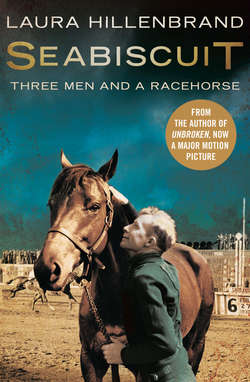Читать книгу Seabiscuit: The True Story of Three Men and a Racehorse - Laura Hillenbrand - Страница 8
PREFACE
ОглавлениеIn 1938, near the end of a decade of monumental turmoil, the year’s number-one newsmaker was not Franklin Delano Roosevelt, Hitler, or Mussolini. It wasn’t Pope Pius XI, nor was it Lou Gehrig, Howard Hughes, or Clark Gable. The subject of the most newspaper column inches in 1938 wasn’t even a person. It was an undersized, crooked-legged racehorse named Seabiscuit.
In the latter half of the Depression, Seabiscuit was nothing short of a cultural icon in America, enjoying adulation so intense and broad-based that it transcended sport. When he raced, his fans choked local roads, poured out of special cross-country “Seabiscuit Limited” trains, packed the hotels, and cleaned out the restaurants. They tucked their Roosevelt dollars into Seabiscuit wallets, bought Seabiscuit hats on Fifth Avenue, played at least nine parlor games bearing his image. Tuning in to radio broadcasts of his races was a weekend ritual across the country, drawing as many as forty million listeners. His appearances smashed attendance records at nearly every major track and drew two of the three largest throngs ever to see a horse race in the United States. In an era when the United States’ population was less than half its current size, seventy-eight thousand people witnessed his last race, a crowd comparable to those at today’s Super Bowls. As many as forty thousand fans mobbed tracks just to watch his workouts, while thousands of others braved ice storms and murderous heat to catch a glimpse of his private eighty-foot Pullman railcar. He galloped over Manhattan on massive billboards and was featured week after week, year after year, in Time, Life, Newsweek, Look, Pic, and The New Yorker. His trainer, jockey, and owner became heroes in their own right. Their every move was painted by the glare of the flashbulb.
They had come from nowhere. The horse, a smallish, mud-colored animal with forelegs that didn’t straighten all the way, spent nearly two seasons floundering in the lowest ranks of racing, misunderstood and mishandled. His jockey, Red Pollard, was a tragic-faced young man who had been abandoned as a boy at a makeshift racetrack cut through a Montana hay field. He came to his partnership with Seabiscuit after years as a part-time prizefighter and failing jockey, lugging his saddle through myriad places, getting punched bloody in cow-town boxing rings, sleeping on stall floors. Seabiscuit’s trainer, a mysterious, virtually mute mustang breaker named Tom Smith, was a refugee from the vanishing frontier, bearing with him generations of lost wisdom about the secrets of horses. Seabiscuit’s owner, a broad, beaming former cavalryman named Charles Howard, had begun his career as a bicycle mechanic before parlaying 21 cents into an automotive empire.
In 1936, on a sultry August Sunday in Detroit, Pollard, Smith, and Howard formed an unlikely alliance. Recognizing the talent dormant in the horse and in one another, they began a rehabilitation of Seabiscuit that would lift him, and them, from obscurity.
For the Seabiscuit crew and for America, it was the beginning of five uproarious years of anguish and exultation. From 1936 to 1940, Seabiscuit endured a remarkable run of bad fortune, conspiracy, and injury to establish himself as one of history’s most extraordinary athletes. Graced with blistering speed, tactical versatility, and indomitable will, he shipped more than fifty thousand exhausting railroad miles, carried staggering weight to victory against the best horses in the country, and shattered more than a dozen track records. His controversial rivalry with Triple Crown winner War Admiral culminated in a spectacular match race that is still widely regarded as the greatest horse race ever run. His epic, trouble-plagued four-year quest to conquer the world’s richest race became one of the most celebrated and widely followed struggles in sports. And in 1940 after suffering severe injuries that were thought to have ended their careers, the aging horse and his jockey returned to the track together in an attempt to claim the one prize that had escaped them.
Along the way, the little horse and the men who rehabilitated him captured the American imagination. It wasn’t just greatness that drew the people to them. It was their story.
It began with a young man on a train, pushing west.
